By Leen Randell
Updated: Jul 19, 2024
10 Best Herbal Creams For Stiff Neck
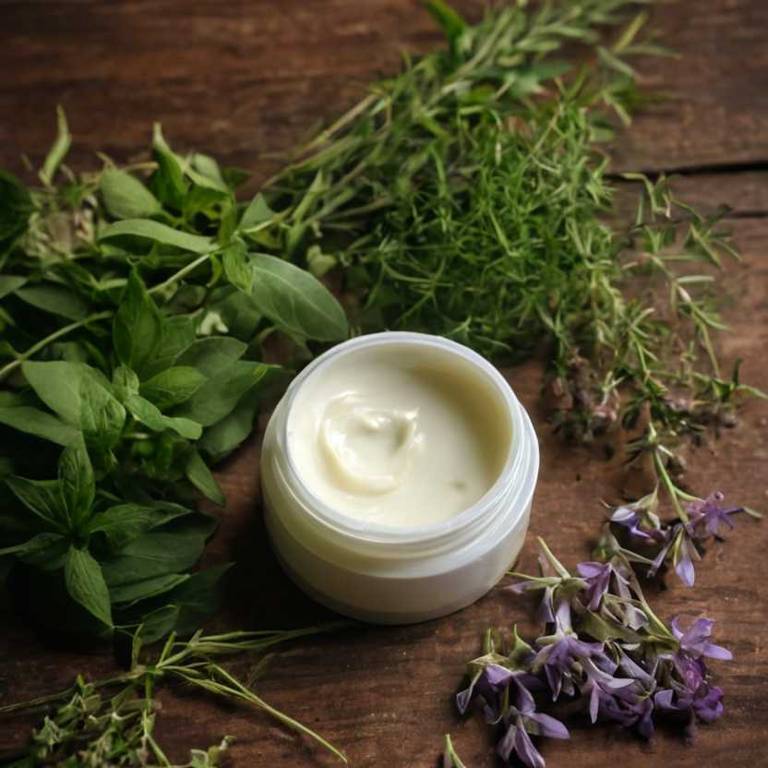
Herbal creams for stiff neck are topical ointments that combine natural herbs and essential oils to provide relief from stiffness and discomfort in the neck and shoulder area.
They typically contain ingredients such as arnica, peppermint, and eucalyptus, which help reduce inflammation and relax muscles. Examples of herbal creams that help with stiff neck include creams containing camphor, menthol, and wintergreen.
By providing quick and effective relief, these creams improve lives by reducing pain and allowing individuals to engage in daily activities with greater ease and comfort.
The following article describes in detail the most important creams for stiff neck, including medicinal properties, parts of herbs to use, and recipes for preparations.
- 1. Salix alba
- 2. Mentha x piperita
- 3. Gaultheria procumbens
- 4. Curcuma longa
- 5. Lavandula angustifolia
- 6. Melissa officinalis
- 7. Pimpinella anisum
- 8. Cymbopogon citratus
- 9. Eucalyptus globulus
- 10. Rosmarinus officinalis
- What is the best combination of herbal creams to use for stiff neck?
- What ailments similar to stiff neck are treated with herbal creams?
1. Salix alba
Salix alba, also known as white willow, creams helps with stiff neck because it contains salicin, a natural anti-inflammatory compound similar to aspirin.
When applied topically, salicin is absorbed through the skin, reducing inflammation and pain in the neck muscles. The cooling and soothing properties of Salix alba cream can also help relax tense neck muscles, providing relief from stiffness and discomfort.
This natural remedy can be a gentle and effective way to alleviate stiff neck, promoting relaxation and flexibility.
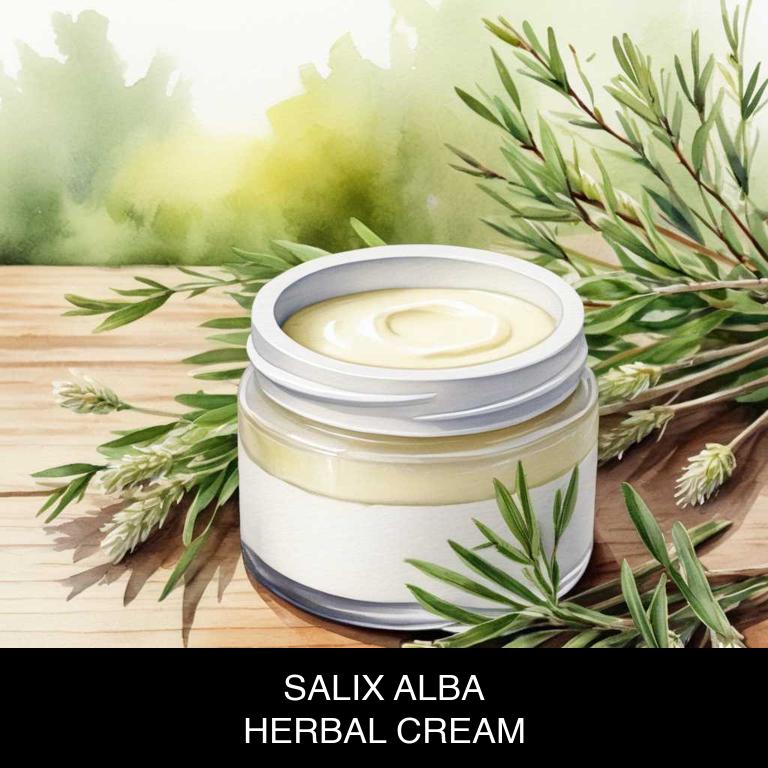
Medicinal Constituents
The list below shows the primary medicinal constituents in Salix alba creams that help with stiff neck.
- Salicin: Acts as a natural anti-inflammatory agent, reducing pain and inflammation in the neck muscles.
- Tannins: Exert astringent and anti-inflammatory properties, helping to reduce swelling and ease tension in stiff neck muscles.
- Flavonoids: Exhibit anti-inflammatory and antioxidant activities, which can help alleviate pain and discomfort associated with stiff neck.
Parts Used
The list below shows the primary parts of white willow used to make creams for stiff neck.
- Barks: The barks are used because they contain salicylic acid, which helps reduce inflammation and ease pain.
- Leaves: The leaves are used due to their high content of salicylic acid and other anti-inflammatory compounds that help soothe stiff necks.
- Stems: The stems are used because they also contain salicylic acid and other medicinal compounds that help alleviate pain and inflammation in the neck.
Quick Recipe
The following recipe gives a procedure to make a basic white willow for stiff neck.
- Harvest 100g of dried salix alba bark from mature trees, ensuring cleanliness and minimal contamination.
- Combine 100g of the harvested bark with 200g of water in a saucepan and bring to a boil.
- Reduce heat and simmer for 30 minutes, then strain the mixture through a cheesecloth to extract the liquid.
- Mix 20g of beeswax with 10g of coconut oil and add the cooled liquid from step 3 to create a smooth paste.
- Pour the mixture into a container and allow it to cool and solidify for at least 2 hours.
2. Mentha x piperita
Mentha x piperita, also known as peppermint, creams helps with stiff neck because of its cooling and anti-inflammatory properties.
The menthol present in peppermint helps to relax tense muscles, reducing pain and discomfort. The cream's ability to penetrate deep into the skin also helps to reduce muscle spasms and stiffness, allowing for improved range of motion and flexibility. Additionally, the refreshing scent of peppermint can also help to reduce stress and promote relaxation, further alleviating stiff neck symptoms.
This makes peppermint creams a popular natural remedy for neck pain.

Medicinal Constituents
The list below shows the primary medicinal constituents in Mentha x piperita creams that help with stiff neck.
- Limonene: This terpene has anti-inflammatory properties that help reduce swelling and pain associated with stiff neck.
- Menthol: As a vasodilator, menthol increases blood flow to the affected area, helping to relax tense muscles and reduce stiffness in the neck.
- Rosmarinic acid: A phenolic compound with anti-inflammatory and antioxidant properties, rosmarinic acid helps reduce inflammation and pain in the neck, promoting relaxation and relief from stiffness.
Parts Used
The list below shows the primary parts of peppermint used to make creams for stiff neck.
- Leaves: They are used for their analgesic and anti-inflammatory properties, which help relieve pain and reduce stiffness in the neck.
- Stems: Stems of Mentha x piperita contain essential oils that have a cooling effect, which can help reduce inflammation and ease stiffness in the neck.
- Rhyzomes: Rhyzomes of Mentha x piperita have been used for their anti-inflammatory and analgesic properties, which can help soothe and relieve pain in the neck.
Quick Recipe
The following recipe gives a procedure to make a basic peppermint for stiff neck.
- Extract the essential oil from mentha x piperita leaves using a steam distillation process for 4 hours.
- Combine 20 grams of the extracted essential oil with 80 grams of a natural emollient in a large mixing bowl.
- Add 10 grams of beeswax to the mixture and heat it in a double boiler for 30 minutes.
- Whip the mixture until it thickens and forms a smooth, creamy consistency using a hand mixer for 5 minutes.
- Pour the herbal mentha x piperita cream into small jars and store them in the refrigerator for up to 6 months.
3. Gaultheria procumbens
Gaultheria procumbens, also known as wintergreen, creams helps with stiff neck because of its anti-inflammatory and analgesic properties.
The cream contains methyl salicylate, a compound similar to aspirin, which helps to reduce pain and inflammation in the affected area. When applied topically, it can penetrate deep into the muscles and joints, providing relief from stiffness and soreness.
Regular use of wintergreen creams can also help to improve range of motion and reduce muscle spasms, making it a popular natural remedy for stiff neck.
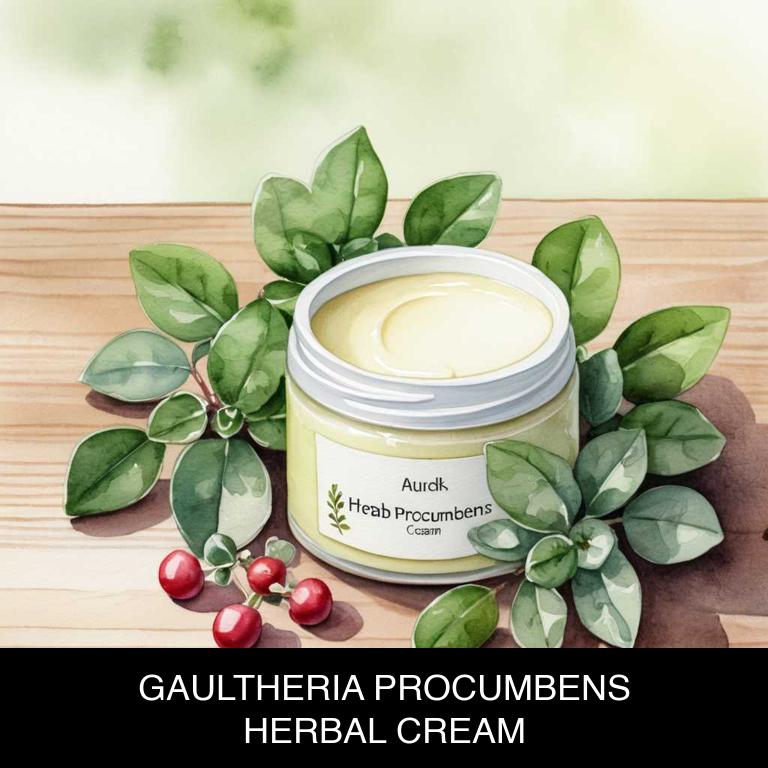
Medicinal Constituents
The list below shows the primary medicinal constituents in Gaultheria procumbens creams that help with stiff neck.
- Gaultherin: Gaultherin, a phenolic compound, has anti-inflammatory and analgesic properties, which help reduce pain and inflammation in stiff neck muscles.
- Methyl salicylate: Methyl salicylate, a volatile oil, acts as a pain reliever and reduces inflammation, providing relief from stiff neck pain and discomfort.
- Betulinic acid: Betulinic acid, a triterpenoid, has anti-inflammatory and antioxidant properties, which help to reduce swelling, pain, and stiffness in the neck muscles.
Parts Used
The list below shows the primary parts of wintergreen used to make creams for stiff neck.
- Leaves: Used for their analgesic and anti-inflammatory properties.
- Roots: Used for their anti-inflammatory and antispasmodic properties, which help relieve muscle tension.
- Barks: Used for their anti-inflammatory and astringent properties, which can help soothe and calm the muscles and skin.
Quick Recipe
The following recipe gives a procedure to make a basic wintergreen for stiff neck.
- Harvest 2-3 cups of gaultheria procumbens leaves and stems in the morning after the dew has evaporated.
- Dry the harvested gaultheria procumbens in a single layer for 7-10 days at 35-40°c using a dehydrator.
- Steep 1 cup of dried gaultheria procumbens in 2 cups of carrier oil such as jojoba or sweet almond oil for 2-4 weeks.
- Strain the infused oil through cheesecloth and discard the solids then add 1 teaspoon of beeswax and 2 tablespoons of aloe vera gel.
- Whip the mixture until it thickens and is smooth then transfer it to a glass jar and store it in the refrigerator.
4. Curcuma longa
Curcuma longa, also known as turmeric, creams helps with stiff neck because of its potent anti-inflammatory properties.
The active compound curcumin in turmeric creams reduces swelling and pain in the neck muscles, providing relief from stiffness. The antioxidants present in turmeric creams also promote relaxation and reduce muscle spasms, making it easier to move the neck without discomfort.
Regular use of turmeric creams can help alleviate chronic stiff neck and promote overall neck health.

Medicinal Constituents
The list below shows the primary medicinal constituents in Curcuma longa creams that help with stiff neck.
- Curcumin: It helps with stiff neck due to its potent anti-inflammatory and antioxidant properties, which reduce inflammation and oxidative stress in the neck muscles.
- Demethoxycurcumin: It contributes to pain relief and anti-inflammatory effects, helping to alleviate stiff neck symptoms by inhibiting the production of pro-inflammatory enzymes.
- Turmerone: It is a sesquiterpene that has anti-inflammatory and antioxidant properties, which help to reduce pain and inflammation in the neck muscles, thereby providing relief from stiff neck.
Parts Used
The list below shows the primary parts of turmeric used to make creams for stiff neck.
- Rhyzomes: They are the primary part used due to their high content of curcumin, a bioactive compound with anti-inflammatory properties.
- Seeds: They contain compounds that may help reduce pain and inflammation, making them a suitable addition to creams for stiff neck.
- Roots: The roots of Curcuma longa also contain curcumin and other beneficial compounds that may help alleviate stiff neck symptoms.
Quick Recipe
The following recipe gives a procedure to make a basic turmeric for stiff neck.
- Grind 1 tablespoon of dried curcuma longa roots into a fine powder using a mortar and pestle for 5 minutes.
- Mix 2 tablespoons of coconut oil and 1 tablespoon of beeswax in a saucepan and heat over low heat for 10 minutes.
- Combine the ground curcuma longa powder with 1 teaspoon of vitamin e oil and 2 drops of lavender essential oil in a separate bowl.
- Gradually add the powder mixture to the coconut oil mixture and stir until well combined for 5 minutes.
- Pour the mixture into a clean glass jar and refrigerate for 30 minutes before using as a face cream.
5. Lavandula angustifolia
Lavandula angustifolia, also known as English lavender, creams helps with stiff neck because of its anti-inflammatory and relaxing properties.
The essential oils in the cream, such as linalool and linalyl acetate, work to calm muscle spasms and reduce tension. This leads to a reduction in pain and discomfort, allowing for improved range of motion and flexibility.
By promoting a sense of calm and relaxation, the cream also helps to reduce stress and anxiety, further contributing to its effectiveness in alleviating stiff neck symptoms.

Medicinal Constituents
The list below shows the primary medicinal constituents in Lavandula angustifolia creams that help with stiff neck.
- Linalool: Helps with stiff neck by acting as a natural anti-inflammatory agent, reducing pain and inflammation in the affected area.
- Linalyl acetate: Contributes to alleviating stiff neck by exhibiting analgesic and antispasmodic properties, which help to relieve pain and muscle spasms.
- Rosmarinic acid: Assists in reducing stiff neck by displaying potent antioxidant and anti-inflammatory properties, which help to protect against oxidative stress and inflammation in the neck muscles.
Parts Used
The list below shows the primary parts of english lavender used to make creams for stiff neck.
- Flowers: Lavender flowers are commonly used due to their high content of essential oils, particularly linalool and linalyl acetate, which have anti-inflammatory and soothing properties.
- Leaves: Lavender leaves are used for their similar composition to flowers, providing a similar set of compounds that help to reduce pain and inflammation associated with a stiff neck.
- Stems: Lavender stems may contain a smaller amount of essential oils compared to flowers and leaves but are still used for their potential anti-inflammatory and analgesic properties.
Quick Recipe
The following recipe gives a procedure to make a basic english lavender for stiff neck.
- Harvest lavandula angustifolia flowers in late morning to ensure optimal essential oil content and freshness.
- Dry the harvested flowers using a food dehydrator or air-dry them in a warm dark place.
- Infuse the dried flowers in a carrier oil such as sweet almond oil for 2-3 weeks.
- Strain the infused oil through a cheesecloth or coffee filter into a clean glass container.
- Whip the infused oil into a creamy texture with a hand mixer or stand mixer.
6. Melissa officinalis
Melissa officinalis, also known as lemon balm, creams helps with stiff neck because of its anti-inflammatory and antispasmodic properties.
The herb's active compounds, such as rosmarinic acid and linalool, work together to relax tense muscles and reduce pain and stiffness in the neck. By applying Melissa officinalis creams topically, individuals can experience relief from the discomfort and tension associated with a stiff neck, promoting relaxation and improved range of motion.
This natural remedy can be a valuable addition to a self-care routine.
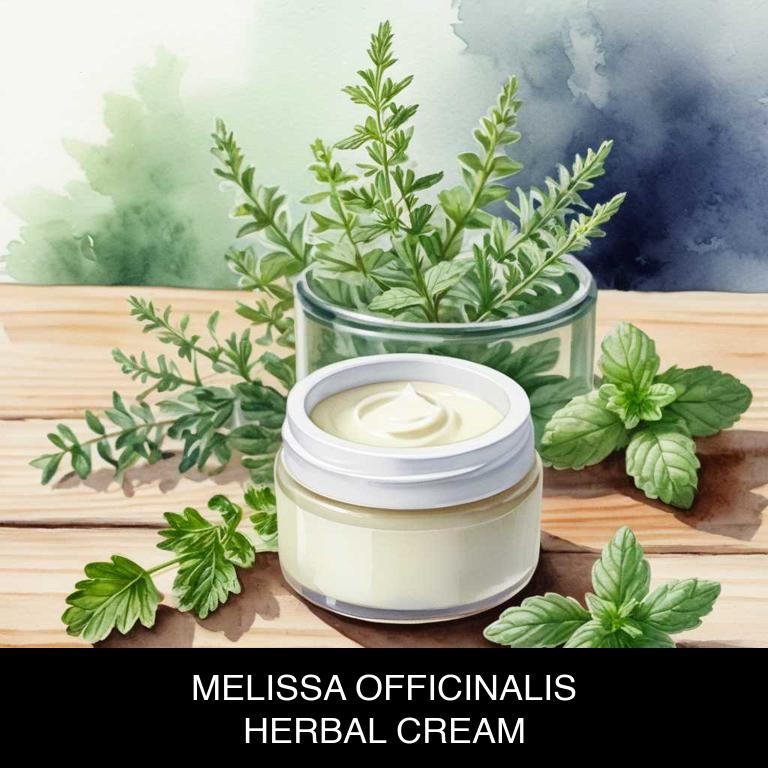
Medicinal Constituents
The list below shows the primary medicinal constituents in Melissa officinalis creams that help with stiff neck.
- Rosmarinic acid: A phenolic compound that acts as a potent anti-inflammatory agent, reducing swelling and pain in the neck muscles.
- Luteolin: A flavonoid with anti-inflammatory and antioxidant properties, which helps to alleviate pain and discomfort in the neck by reducing inflammation and promoting healing.
- Melissic acid: A triterpene acid that exhibits anti-inflammatory and analgesic properties, providing relief from pain and stiffness in the neck muscles by reducing inflammation and modulating pain pathways.
Parts Used
The list below shows the primary parts of lemon balm used to make creams for stiff neck.
- Leaves: They are rich in antioxidants and flavonoids, which help soothe and relax muscles, reducing stiffness and discomfort.
- Stems: Similar to leaves, stems contain beneficial compounds that aid in relaxation and ease muscle tension.
- Roots: The roots of Melissa officinalis are often used in herbal remedies due to their anti-inflammatory properties, which can help alleviate stiff neck pain.
Quick Recipe
The following recipe gives a procedure to make a basic lemon balm for stiff neck.
- Harvest melissa officinalis leaves and flowers from a clean and organic source when in full bloom.
- Dry the harvested melissa officinalis in a warm dry place for at least 7 days.
- Infuse 25 grams of dried melissa officinalis in 500 milliliters of carrier oil like coconut oil for 2 weeks.
- Strain the infused oil through cheesecloth and mix it with 250 grams of beeswax and 100 grams of shea butter.
- Heat the mixture at 60 degrees celsius for 30 minutes to create a smooth and creamy texture.
7. Pimpinella anisum
Pimpinella anisum, also known as anise, creams helps with stiff neck because of its anti-inflammatory and warming properties.
The cream's active compounds, such as anethole, help to reduce muscle tension and relax the neck muscles, providing quick relief from stiffness and soreness. Additionally, anise has natural analgesic properties that help to ease pain and discomfort, making it an effective remedy for soothing stiff necks and promoting overall neck health and well-being.
It's a natural and gentle solution for aching necks.
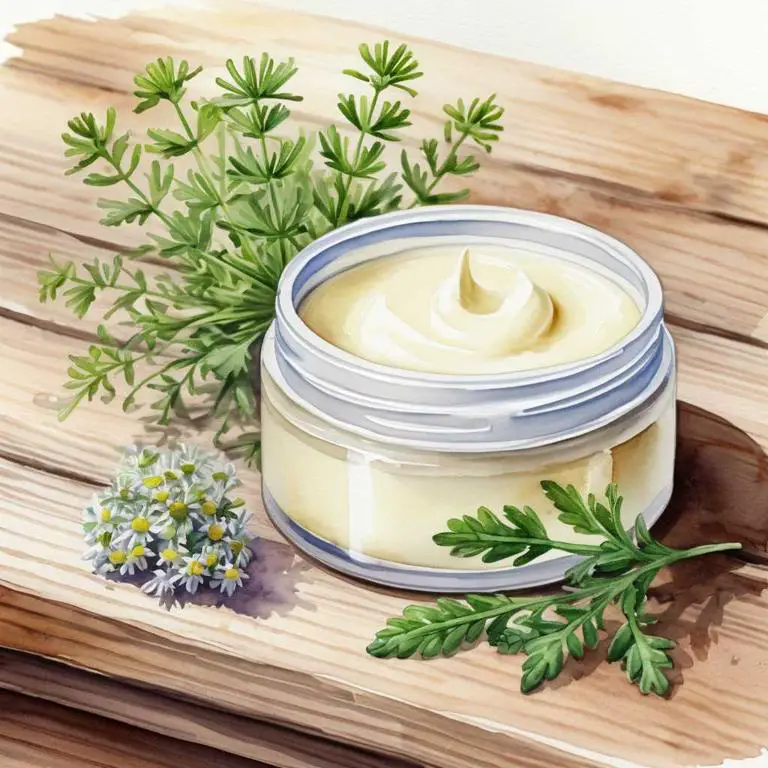
Medicinal Constituents
The list below shows the primary medicinal constituents in Pimpinella anisum creams that help with stiff neck.
- Anethole: A phenolic compound that acts as a natural anti-inflammatory and analgesic, helping to reduce pain and discomfort associated with a stiff neck.
- Limonene: A terpene with anti-inflammatory and antioxidant properties, which may help to relax muscles, reduce stiffness, and promote healing in the affected area.
- Apigenin: A flavonoid with anti-inflammatory and analgesic properties, which may help to reduce pain, inflammation, and discomfort associated with a stiff neck, promoting relaxation and relaxation of the affected muscles.
Parts Used
The list below shows the primary parts of anise used to make creams for stiff neck.
- Seeds: They are used for their carminative and anti-inflammatory properties, which help to soothe and relax the muscles.
- Leaves: They contain various bioactive compounds that exhibit anti-inflammatory and antioxidant effects, contributing to their potential use in creams for stiff neck relief.
- Flowers: Their essential oils are believed to possess analgesic and anti-inflammatory properties, which can aid in reducing stiffness and pain in the neck.
Quick Recipe
The following recipe gives a procedure to make a basic anise for stiff neck.
- Gather 1/4 cup of dried pimpinella anisum flowers and 1/4 cup of sweet almond oil for the recipe.
- Combine 2 tablespoons of beeswax and 2 tablespoons of coconut oil in a double boiler to melt.
- Add the dried pimpinella anisum flowers to the melted beeswax and coconut oil mixture.
- Heat the mixture for 10 minutes while stirring occasionally to infuse the herb's properties.
- Strain the mixture through a cheesecloth into a bowl to remove the pimpinella anisum flowers.
8. Cymbopogon citratus
Cymbopogon citratus, also known as lemongrass, creams helps with stiff neck because of its anti-inflammatory properties.
The active compounds present in lemongrass, such as citral and geraniol, have been shown to reduce muscle spasms and relax tense muscles, providing relief from stiffness and soreness. Additionally, lemongrass creams have antimicrobial properties that help to prevent infection and promote healing in the affected area.
These properties make lemongrass creams an effective remedy for relieving stiff neck pain and promoting overall well-being.
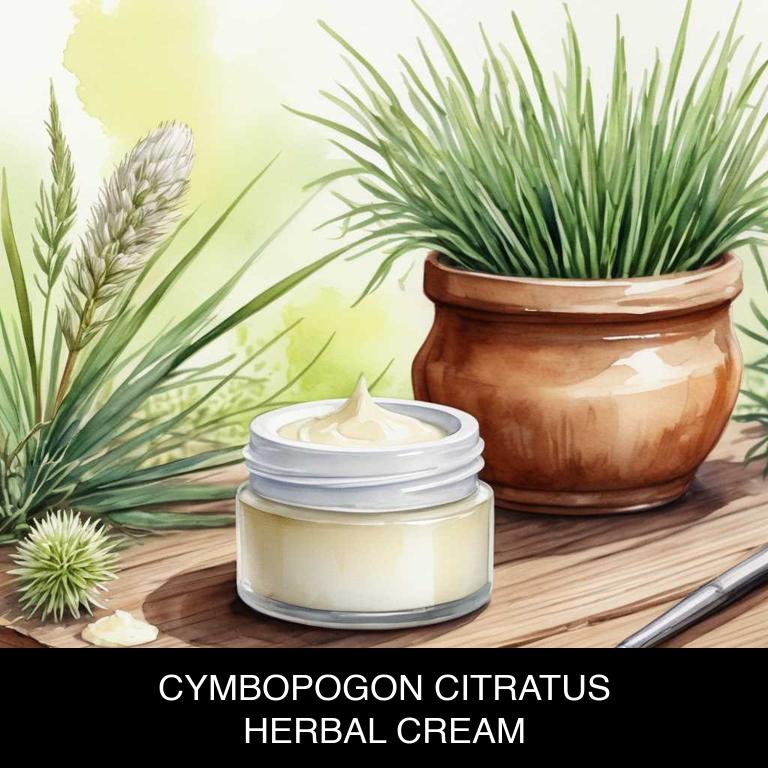
Medicinal Constituents
The list below shows the primary medicinal constituents in Cymbopogon citratus creams that help with stiff neck.
- Citrals: Citrals have anti-inflammatory properties that help reduce pain and swelling associated with stiff neck, providing relief and relaxation.
- Zingiberene: Zingiberene has analgesic and anti-inflammatory effects, which can help alleviate neck pain and stiffness by reducing inflammation and promoting relaxation.
- Rosmarinic acid: Rosmarinic acid has anti-inflammatory and antioxidant properties that may help reduce muscle tension, alleviate pain, and promote recovery from stiff neck.
Parts Used
The list below shows the primary parts of lemongrass used to make creams for stiff neck.
- Leaves: They are commonly used due to their high citral and limonene content, which have anti-inflammatory and antispasmodic properties that help relieve neck stiffness and pain.
- Rhyzomes: Rhyzomes are used for their medicinal properties, including their anti-inflammatory and antispasmodic effects, which help to soothe and relax the muscles in the neck.
- Stems: Stems of Cymbopogon citratus are used for their antimicrobial and anti-inflammatory properties, which can help to reduce inflammation and promote healing in the affected area.
Quick Recipe
The following recipe gives a procedure to make a basic lemongrass for stiff neck.
- Weigh 250g of distilled water and 20g of cymbopogon citratus essential oil in a clean measuring cup.
- Add 1 teaspoon of sodium lauryl sulfoacetate and 0.5 teaspoons of glycerin to the distilled water.
- Combine the essential oil and surfactant mixture in a 500ml double boiler.
- Melt 30g of shea butter and 20g of coconut oil in a separate double boiler.
- Blend the essential oil mixture with the shea butter and coconut oil mixture thoroughly.
9. Eucalyptus globulus
Eucalyptus globulus, also known as Tasmanian blue gum, creams helps with stiff neck because of its anti-inflammatory and decongestant properties.
The menthol content in Eucalyptus globulus cream helps to relax muscles, reduce pain and inflammation, and improve blood circulation to the affected area. As a result, it provides quick relief from stiff neck discomfort, allowing for a range of motion and promoting overall well-being.
Its invigorating scent also helps to uplift and relax the mind and body.
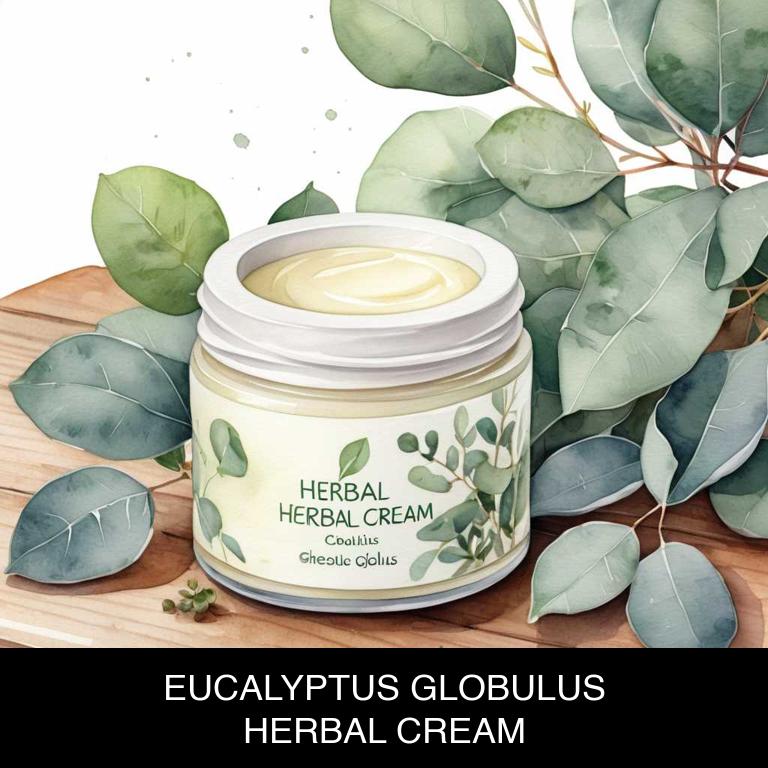
Medicinal Constituents
The list below shows the primary medicinal constituents in Eucalyptus globulus creams that help with stiff neck.
- Cineole: This compound helps with stiff neck by reducing inflammation and pain through its analgesic and anti-inflammatory properties.
- Caffeic acid: This phenolic compound assists in alleviating stiff neck by reducing oxidative stress and inflammation, promoting relaxation and pain relief.
- Α-pinene: This terpene helps with stiff neck by inhibiting pro-inflammatory enzymes and reducing muscle spasms, thereby providing relief from pain and discomfort.
Parts Used
The list below shows the primary parts of tasmanian blue gum used to make creams for stiff neck.
- Leaves: Used due to their high content of eucalyptol, a natural decongestant and anti-inflammatory compound.
- Barks: Utilized for their anti-inflammatory and antiseptic properties, which can help soothe and calm stiff neck muscles.
- Essential oil from leaves: This is often extracted from the leaves and added to creams, providing relief from pain and stiffness due to its anti-inflammatory properties.
Quick Recipe
The following recipe gives a procedure to make a basic tasmanian blue gum for stiff neck.
- Harvest 500g of dried eucalyptus globulus leaves from a reliable source and sift them to remove any debris.
- Infuse 100g of the sifted leaves in 500ml of carrier oil such as sweet almond oil for 2-3 weeks.
- Strain the infused oil through cheesecloth or a coffee filter to separate the liquid from the solids.
- Mix the strained oil with 100g of beeswax and 50g of shea butter in a double boiler.
- Whip the cooled mixture with a hand mixer until it becomes light and fluffy, then transfer it to a container.
10. Rosmarinus officinalis
Rosmarinus officinalis, also known as rosemary, creams helps with stiff neck because of its anti-inflammatory and analgesic properties.
The essential oils present in rosemary, such as borneol and camphor, have been shown to reduce muscle tension and pain. The cream also contains antioxidants that help to protect the muscles from oxidative stress, promoting relaxation and reducing stiffness.
Regular application of rosemary cream can lead to improved range of motion and reduced discomfort, making it a popular natural remedy for stiff neck relief.
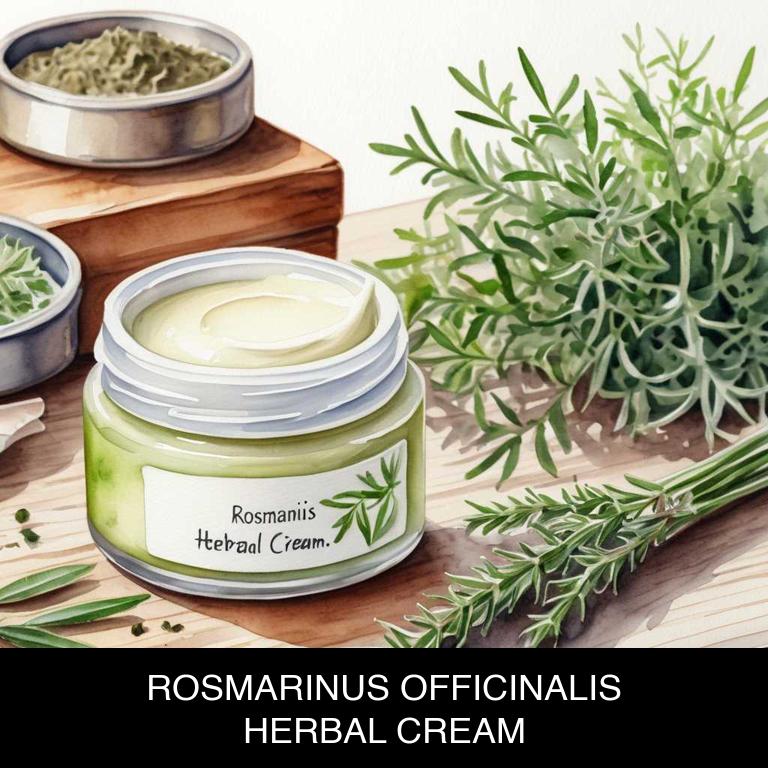
Medicinal Constituents
The list below shows the primary medicinal constituents in Rosmarinus officinalis creams that help with stiff neck.
- Rosmarinic acid: This phenolic compound helps alleviate stiff neck by reducing inflammation and oxidative stress, thereby relieving pain and discomfort.
- Carnosic acid: A phenolic diterpene, carnosic acid helps reduce inflammation and oxidative stress, which can contribute to stiff neck, and also has antioxidant properties to promote overall well-being.
- Rosmarinus iridoids: These iridoid glycosides exhibit anti-inflammatory and analgesic properties, which can help relieve stiff neck pain and discomfort by reducing inflammation and promoting relaxation.
Parts Used
The list below shows the primary parts of rosemary used to make creams for stiff neck.
- Leaves: They are rich in antioxidants and essential oils, which help to relax muscles and reduce pain.
- Flowers: They contain anti-inflammatory compounds that help to soothe and calm the muscles, relieving stiffness and tension.
Quick Recipe
The following recipe gives a procedure to make a basic rosemary for stiff neck.
- Infuse dried rosmarinus officinalis leaves in a carrier oil like sweet almond oil at a ratio of 1:5 for 2-3 weeks.
- Strain the infused oil through a cheesecloth or a coffee filter into a clean glass container.
- Weigh out beeswax and shea butter according to a 1:1 ratio of 10% of the total weight of the mixture.
- Heat the infused oil mixture with the weighed beeswax and shea butter until it reaches a temperature of 160-180 degrees fahrenheit.
- Pour the hot mixture into a clean glass container and allow it to cool and solidify completely before use.
What is the best combination of herbal creams to use for stiff neck?
The best combination of herbal creams that help with stiff neck is a blend of arnica, peppermint, and eucalyptus.
Arnica oil reduces inflammation and swelling, while peppermint oil cools and relaxes the muscles. Eucalyptus oil, rich in anti-inflammatory properties, helps to ease tension and promote blood flow.
Applying a mixture of these creams to the affected area can provide quick relief from stiffness and discomfort. Regular use can also help to prevent future occurrences of stiff neck.
This combination is a natural and effective way to promote neck health.
What ailments similar to stiff neck are treated with herbal creams?
Ailments similar to stiff neck that are treated with herbal creams are tension headaches, migraines, and sciatica.
These creams often contain ingredients such as arnica, peppermint, and ginger, which help to reduce inflammation and relax muscles. They may also include herbs like lavender and chamomile, which promote relaxation and calmness.
By applying these topical creams, individuals can alleviate discomfort and stiffness in their necks, shoulders, and backs, promoting overall well-being and reducing pain.